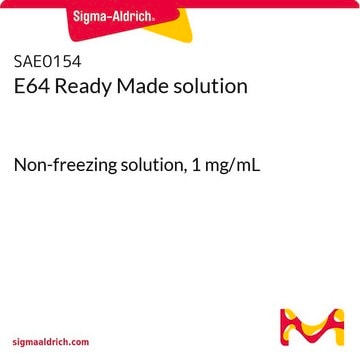Z720046
Millipore® Ziptips
C18, rack of 96
Sinonimo/i:
pipet tips, pipette tips
Autenticatiper visualizzare i prezzi riservati alla tua organizzazione & contrattuali
About This Item
Codice UNSPSC:
41121500
NACRES:
NB.01
Prodotti consigliati
Materiali
colorless tip
Sterilità
non-sterile
Caratteristiche
barrier: no
Confezionamento
rack of 96
Produttore/marchio commerciale
Millipore ZTC18s960
Intervallo di volume
0.1-10 μL
Cerchi prodotti simili? Visita Guida al confronto tra prodotti
Descrizione generale
Millipore ZipTips: Sample Preparation of Peptides or Proteins Prior to Electrospray/Nanoelectrospray MS
ZipTip Advantages:
Examples of analyses enhanced by ZipTip sample preparation:
The ZipTip is a 10 μL (P-10) pipette tip with a bed of chromatography media fixed at its end such that there is no dead volume. It is intended for purifying and concentrating femtomoles to picomoles of protein, peptide or oligonucleotide samples prior to analysis, providing better data quality. The sample is aspirated and dispensed through ZipTip to bind, wash, and elute. Recovered samples are contaminant-free and eluted in 0.5-4 μL for direct transfer to a mass spectrometer target or vial.
ZipTip C18 is a 10 μL pipette tip with approximately a 0.6 μL bed of chromatography media fixed at its end such that there is no dead volume. ZipTip Micro-C18 is a 10 μL pipette tip with approximately a 0.2 μL bed of chromatography media fixed at its end such that there is no dead volume. Both are ideal for concentrating and purifying peptides, proteins or oligonucleotides in seconds prior to mass spectrometry, HPLC, capillary electrophoresis and other analytical techniques.
ZipTip Advantages:
- Single-step desalting, concentration, and purification
- Fractionate complex samples for more meaningful data
- Ideal for peptides, proteins, nucleic acids, and more
- No dead volume for maximum recovery
- Eliminates time-consuming chromatography
Examples of analyses enhanced by ZipTip sample preparation:
- Mass spectrometry
- HPLC (high performance liquid chromatography)
- Capillary electrophoresis
- Atomic absorption spectroscopy
The ZipTip is a 10 μL (P-10) pipette tip with a bed of chromatography media fixed at its end such that there is no dead volume. It is intended for purifying and concentrating femtomoles to picomoles of protein, peptide or oligonucleotide samples prior to analysis, providing better data quality. The sample is aspirated and dispensed through ZipTip to bind, wash, and elute. Recovered samples are contaminant-free and eluted in 0.5-4 μL for direct transfer to a mass spectrometer target or vial.
ZipTip C18 is a 10 μL pipette tip with approximately a 0.6 μL bed of chromatography media fixed at its end such that there is no dead volume. ZipTip Micro-C18 is a 10 μL pipette tip with approximately a 0.2 μL bed of chromatography media fixed at its end such that there is no dead volume. Both are ideal for concentrating and purifying peptides, proteins or oligonucleotides in seconds prior to mass spectrometry, HPLC, capillary electrophoresis and other analytical techniques.
Note legali
Millipore is a registered trademark of Merck KGaA, Darmstadt, Germany
Scegli una delle versioni più recenti:
Certificati d'analisi (COA)
Lot/Batch Number
It looks like we've run into a problem, but you can still download Certificates of Analysis from our Documenti section.
Se ti serve aiuto, non esitare a contattarci Servizio Clienti
Possiedi già questo prodotto?
I documenti relativi ai prodotti acquistati recentemente sono disponibili nell’Archivio dei documenti.
Dae-Hee Lee et al.
Autophagy, 14(11), 1870-1885 (2018-07-07)
Macroautophagy is induced under various stresses to remove cytotoxic materials, including misfolded proteins and their aggregates. These protein cargoes are collected by specific autophagic receptors such as SQSTM1/p62 (sequestosome 1) and delivered to phagophores for lysosomal degradation. To date, little
Arman Kulyyassov et al.
Biomolecules, 10(1) (2020-01-23)
Protein-protein interactions of core pluripotency transcription factors play an important role during cell reprogramming. Cell identity is controlled by a trio of transcription factors: Sox2, Oct4, and Nanog. Thus, methods that help to quantify protein-protein interactions may be useful for
Il team dei nostri ricercatori vanta grande esperienza in tutte le aree della ricerca quali Life Science, scienza dei materiali, sintesi chimica, cromatografia, discipline analitiche, ecc..
Contatta l'Assistenza Tecnica.





